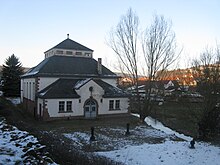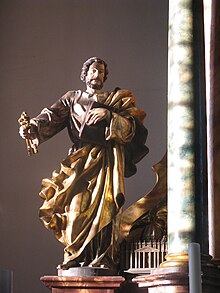Mernes
|
Mernes
City of Bad Soden-Salmünster
Coordinates: 50 ° 14 ′ 22 " N , 9 ° 28 ′ 45" E
|
|
|---|---|
| Height : | 274 m above sea level NHN |
| Area : | 8.37 km² |
| Residents : | 800 (approx.) |
| Population density : | 96 inhabitants / km² |
| Incorporation : | July 1, 1974 |
| Postal code : | 63628 |
| Area code : | 06660 |
Mernes is the southernmost district of Bad Soden-Salmünster in the Main-Kinzig district in East Hesse . The village is about 60 km east of Frankfurt in the Hessischer Spessart Nature Park and is a state-approved resort. Mernes has just under 900 inhabitants.
Geographical location
Mernes is located eight kilometers south-east of Salmünster across a ridge of the Spessart , and separated from the rest of Bad Soden-Salmünster as an exclave by the Spessart estate , on a bridge over the Jossa and borders on Bavaria. The border runs directly behind the summit of the nearby Stackenberg ( 464.5 m above sea level ), which rises largely free of forests above the town. Neighboring in the northeast are the villages of Marjoss (town of Steinau an der Straße ) and in the south of Burgjoss (municipality of Jossgrund ).
history
According to archaeological finds, the area around the Stacken was inhabited as early as the Neolithic. The 1059 survey was mentioned in a document as "Stegun" as a border designation. Mernolfes is first mentioned in 1267, on a map from the 16th century it is called Merles . Stacken, which is now wooded, was used for agriculture in the Middle Ages. One of the oldest boundary stones in the Spessart (dated 1559) documents the Stacken as a borderland between the County of Hanau , the Lords of Hutten , the Lords of Thüngen and Kurmainz after the Counts of Rieneck died out that same year. In the 19th century the Stacken was the borderland between the kingdoms of Prussia (before 1866 Kurhessen ) and Bavaria .
A curious contract from 1913 with the Prussian military grants the citizens of the village free drinking water to this day. The city of Frankfurt am Main is now obliged to act as legal successor.
Mernes was on July 1, 1974 the course of municipal reform in Hesse powerful state law with the cities "Bad Soden near Salmünster" and Salmuenster the new town of Bad Orb together .
Population development
Source: Historical local dictionary
| • 1632: | 36 employees |
| • 1811: | 68 fire places with 516 souls |
| Mernes: Population from 1811 to 1970 | ||||
|---|---|---|---|---|
| year | Residents | |||
| 1811 | 516 | |||
| 1834 | 637 | |||
| 1840 | 627 | |||
| 1846 | 620 | |||
| 1852 | 616 | |||
| 1858 | 596 | |||
| 1864 | 627 | |||
| 1871 | 609 | |||
| 1875 | 598 | |||
| 1885 | 565 | |||
| 1895 | 570 | |||
| 1905 | 576 | |||
| 1910 | 591 | |||
| 1925 | 596 | |||
| 1939 | 644 | |||
| 1946 | 939 | |||
| 1950 | 871 | |||
| 1956 | 730 | |||
| 1961 | 706 | |||
| 1967 | 751 | |||
| 1970 | 767 | |||
| Data source: Historical municipality register for Hesse: The population of the municipalities from 1834 to 1967. Wiesbaden: Hessisches Statistisches Landesamt, 1968. Other sources: | ||||
Religious affiliation
Source: Historical local dictionary
| • 1885: | 6 Protestant (= 1.06%), 559 Catholic (= 98.94%) residents |
| • 1961: | 35 Protestant (= 4.96%), 667 Catholic (= 94.48%) residents |
religion
The Roman Catholic parish church of St. Peter is in Mernes . The parish of Mernes is located in the diocese of Fulda and belongs to the pastoral association "St. Martin im Spessart".
Attractions
In addition to the forest landscape with its own network of hiking trails and a few restaurants, the spring swimming pool is an attraction for leisure activities and tourism. From Stacken (465 m), which features orchards and spruce forests as well as naturally grown landscapes such as juniper heather and arnica meadows, there is a view far into the Rhön on a clear day .
- St. Peter's Church . The Church of St. Peter, built between 1660 and 1671, was expanded in 1934; as a result of the renovation, the church is now unusually oriented to the north instead of the usual east. The interior of the unadorned exterior contains some pieces of equipment from the church in Lettgenbrunn , which was destroyed by bombing exercises at the Gelnhausen-Rothenbergen air base after 1935 and which had previously been brought to safety in Mernes when the settlement was cleared: A high altar with a crucifixion group from the school Tilman Riemenschneider , a baptismal font and a Marienaltar.
- The Mernes waterworks is an Art Nouveau industrial monument from the years 1913-14. Inside there are still machines, motors, pumps and tools from the time it was built, but they are no longer used. Originally, the waterworks was built to supply the military training area at the Wegscheide ; the 1913 contract between the then Mernes mayor Hieronymus König and the military administration provided for a free supply of drinking water to the community of Mernes. This contract has never been canceled and is therefore still in force. Today the owner of the waterworks is the city of Bad Orb and the leaseholder is the city of Frankfurt; Today, instead of the no longer existing military training area, the school camp is supplied at the Wegscheide. The waterworks is in need of renovation and no longer complies with today's technical and hygienic regulations. A local support association tries to raise funds to secure the stock.
- The NABU local group has created a nature trail in the village with exhibits and explanations on various topics, for example an insect wall for solitary bees and wasps and a dry stone wall .
- Two undershot mill wheels are still preserved from the Kröckelmühle . The building itself - a half-timbered building - had to give way to a simple new building in 1992.
- A reproduction of the first mentioning document from 1267 can be read on the old village fountain: Members of the Gelnhausen Castle Court generally announce that the sons of Rudolf von Mernolfes and his co-heirs waive claims to goods in Neuses, Wolfram von Neuses, citizens of Gelnhausen, the monastery Meerholz had transferred forever; the names of the signatories and the witnesses follow.
- The European cultural cycle and hiking trail "Perlen der Jossa" (" Archaeological Spessart Project ") leads through Mernes and has a station there with an explanation board. The name refers to the river pearl mussel that was found in the Jossa in the past . The route in the Jossa valley coincides with the Hessian apple wine and orchard route .
- The Spessartbogen long-distance hiking trail also crosses Mernes and, coming from the ridges not far from the Wegscheide , leads on a scenic high path down into the Jossatal and across the river over the Stacken above Marjoss. At the edge of the forest is the so-called "Spessarträuber Hut", where local guides organize robber fun events and survival courses for interested groups .
- 1950s private museum. The approximately 300 square meter 50s private museum is one of the most attractive excursion destinations in the Hessian resort of Mernes. Museum founder Michael Gombert has been collecting everything technical from the time of the economic miracle since his childhood. Visitors who are interested in a short trip through the time when Rama was still spelled with "h" are guaranteed to get their money's worth here with a guided tour. The objects collected have a very special history, have been restored and old devices made fully functional again. The numerous collections in the 1950s private museum include a small school, a corner shop, various pieces of furniture, vehicles, washing machines and clothing. Jukeboxes from the USA and Germany complete the picture of the comfortable time.
Infrastructure
The distance to the Autobahn connection Bad Soden-Salmünster of the A 66 is about 12 km. The Bad Soden-Salmünster station on the Kinzig Valley Railway and the Jossa station on the Flieden – Gemünden railway line offer connections to rail traffic .
In Mernes there is a Catholic kindergarten with a group. The pupils attend the primary school in Jossgrund .
Individual evidence
- ↑ a b c d Mernes, Main-Kinzig district. Historical local dictionary for Hessen. (As of May 24, 2018). In: Landesgeschichtliches Informationssystem Hessen (LAGIS).
- ↑ District Mernes on the website of the city of Bad Soden-Salmünste, accessed in February 2016
- ↑ Frankfurter Rundschau (ed.): Unloved treasure from January 21, 2014 . Frankfurter Rundschau, Frankfurt am Main 2014, p. R8 .
- ↑ Law on the reorganization of the districts of Gelnhausen, Hanau and Schlüchtern and the city of Hanau as well as the recirculation of the cities of Fulda, Hanau and Marburg (Lahn) concerning questions (GVBl. 330-26) of March 12, 1974 . In: The Hessian Minister of the Interior (ed.): Law and Ordinance Gazette for the State of Hesse . 1974 No. 9 , p. 149 , § 12 ( online at the information system of the Hessian state parliament [PDF; 3.0 MB ]).
- ^ Federal Statistical Office (ed.): Historical municipality directory for the Federal Republic of Germany. Name, border and key number changes in municipalities, counties and administrative districts from May 27, 1970 to December 31, 1982 . W. Kohlhammer, Stuttgart / Mainz 1983, ISBN 3-17-003263-1 , p. 377 .
- ↑ Dean's offices, pastoral associations, parishes . bistum-fulda.de. Retrieved September 9, 2019.
Web links
- District Mernes on the website of the city of Bad Soden-Salmünster.
- Mernes. Local history, information. In: www.mernes.de. Local history and tourist association Mernes
- Mernes, Main-Kinzig district. Historical local dictionary for Hessen. In: Landesgeschichtliches Informationssystem Hessen (LAGIS).
- Literature about Mernes in the Hessian Bibliography


